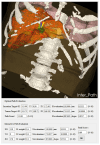Design of Path-Planning System for Interventional Thermal Ablation of Liver Tumors Based on CT Images
- PMID: 38894328
- PMCID: PMC11175280
- DOI: 10.3390/s24113537
Design of Path-Planning System for Interventional Thermal Ablation of Liver Tumors Based on CT Images
Abstract
Objective: Aiming at the shortcomings of artificial surgical path planning for the thermal ablation of liver tumors, such as the time-consuming and labor-consuming process, and relying heavily on doctors' puncture experience, an automatic path-planning system for thermal ablation of liver tumors based on CT images is designed and implemented.
Methods: The system mainly includes three modules: image segmentation and three-dimensional reconstruction, automatic surgical path planning, and image information management. Through organ segmentation and three- dimensional reconstruction based on CT images, the personalized abdominal spatial anatomical structure of patients is obtained, which is convenient for surgical path planning. The weighted summation method based on clinical constraints and the concept of Pareto optimality are used to solve the multi-objective optimization problem, screen the optimal needle entry path, and realize the automatic planning of the thermal ablation path. The image information database was established to store the information related to the surgical path.
Results: In the discussion with clinicians, more than 78% of the paths generated by the planning system were considered to be effective, and the efficiency of system path planning is higher than doctors' planning efficiency.
Conclusion: After improvement, the system can be used for the planning of the thermal ablation path of a liver tumor and has certain clinical application value.
Keywords: Pareto optimality; surgical planning; system design; thermal ablation of tumors; weighted summation.
Conflict of interest statement
The authors declare they have no competing interests. The authors alone are responsible for the content and writing of the paper.
Figures








Similar articles
-
Multi-stage automatic and rapid ablation and needle trajectory planning method for CT-guided percutaneous liver tumor ablation.Med Phys. 2025 Jan;52(1):113-130. doi: 10.1002/mp.17450. Epub 2024 Oct 10. Med Phys. 2025. PMID: 39387846 Free PMC article.
-
An Automatic Needle Puncture Path-Planning Method for Thermal Ablation of Lung Tumors.Diagnostics (Basel). 2024 Jan 19;14(2):215. doi: 10.3390/diagnostics14020215. Diagnostics (Basel). 2024. PMID: 38275462 Free PMC article.
-
Flexible needle puncture path planning for liver tumors based on deep reinforcement learning.Phys Med Biol. 2022 Sep 26;67(19). doi: 10.1088/1361-6560/ac8fdd. Phys Med Biol. 2022. PMID: 36067775
-
[The role of 3-D imaging and computer-based postprocessing for surgery of the liver and pancreas].Rofo. 2005 Sep;177(9):1219-26. doi: 10.1055/s-2005-858376. Rofo. 2005. PMID: 16123867 Review. German.
-
Imaging and Image-Guided Thermal Ablation for Oligometastatic Colorectal Cancer Liver Disease.Cancer J. 2020 Mar/Apr;26(2):124-128. doi: 10.1097/PPO.0000000000000440. Cancer J. 2020. PMID: 32205536 Review.
Cited by
-
Rapid Path Planning Algorithm for Percutaneous Rigid Needle Biopsy Based on Optical Illumination Principles.Sensors (Basel). 2025 Mar 28;25(7):2137. doi: 10.3390/s25072137. Sensors (Basel). 2025. PMID: 40218649 Free PMC article.
References
-
- Chhikara B.S., Parang K. Global Cancer Statistics 2022: The trends projection analysis. Chem. Biol. Lett. 2023;10:451
-
- Calandri M., Mauri G., Yevich S., Gazzera C., Basile D., Gatti M., Veltri A., Fonio P. Fusion imaging and virtual navigation to guide percutaneous thermal ablation of hepatocellular carcinoma: A review of the literature. Cardiovasc. Interv. Radiol. 2019;42:639–647. doi: 10.1007/s00270-019-02167-z. - DOI - PubMed
-
- Wu B., Xiao Y.Y., Zhang X., Zhang A.L., Li H.J., Gao D.F. Magnetic resonance imaging-guided percutaneous cryoablation of hepatocellular carcinoma in special regions. Hepatobiliary Pancreat. Dis. Int. 2010;9:384–392. - PubMed
MeSH terms
Grants and funding
LinkOut - more resources
Full Text Sources
Medical

